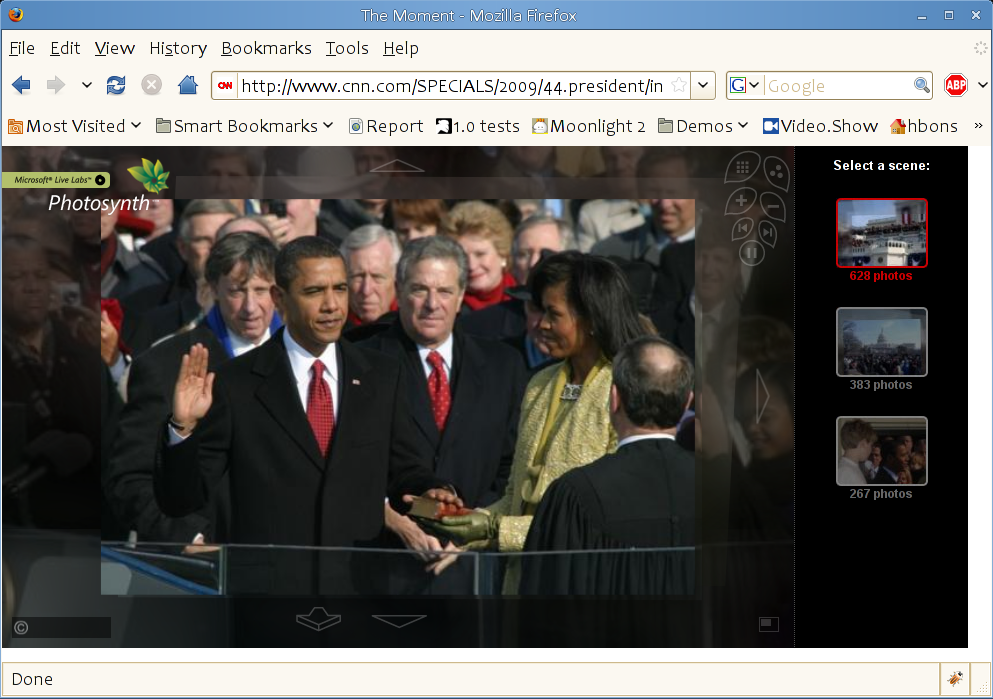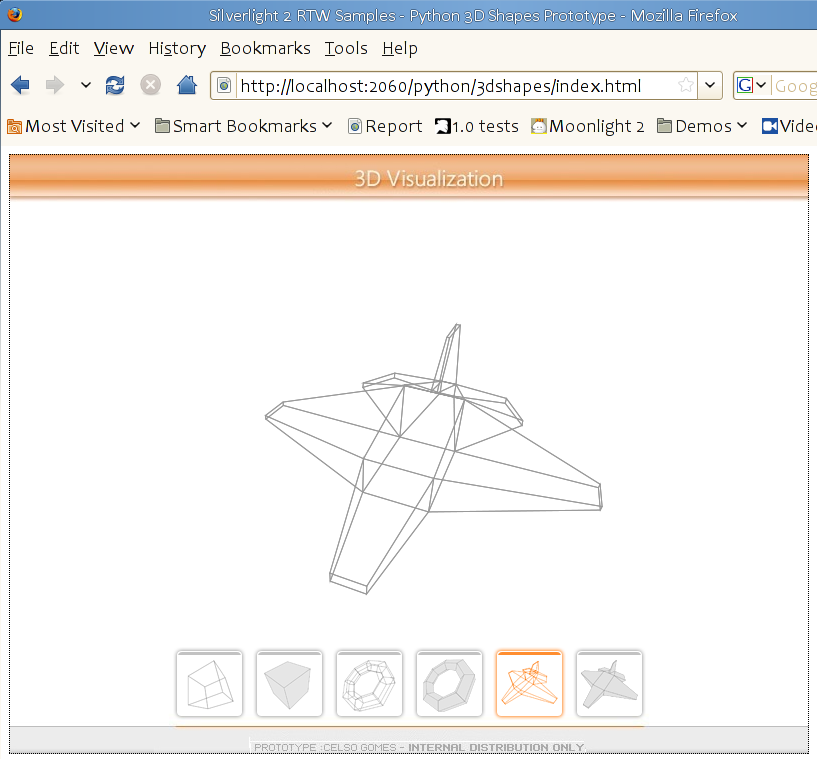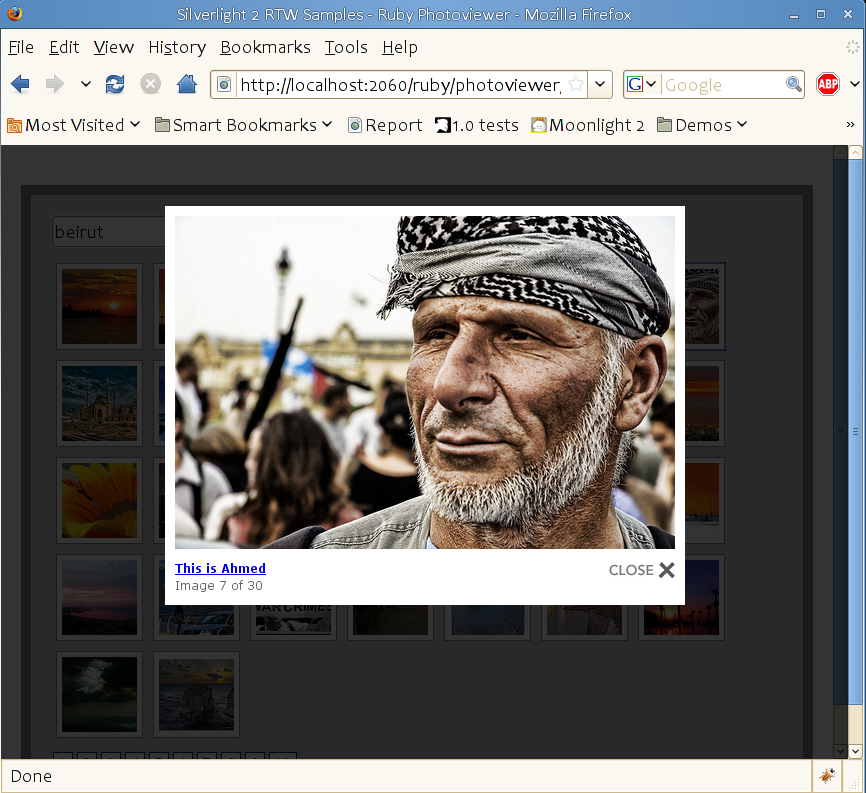Moonlight 1.0 goes live
 Moonlight, the open source implementation of Silverlight
for Unix systems has officially reached its 1.0 level. We
are feature complete, we pass all the Microsoft regression
test suites and we shipped support for Microsoft's Media Pack
for x86 and x86-64 architectures.
Moonlight, the open source implementation of Silverlight
for Unix systems has officially reached its 1.0 level. We
are feature complete, we pass all the Microsoft regression
test suites and we shipped support for Microsoft's Media Pack
for x86 and x86-64 architectures.
Moonlight is available as a Firefox plugin that can be installed with a single click from the moonlight download page.
What is in Moonlight 1.0
Moonlight 1.0 contains our plugin that can be used in Firefox 2 and 3 on Unix systems using the X11 windowing system.
Moonlight 1.0 (and Silverlight 1.0) both come with a graphics pipeline, video and audio frameworks and a javascript bridge and neither one of them contains an actual execution environment. The execution environment is the browser's own Javascript engine. When developers build 1.0-based plugins they script all of the functionality using the browser's own Javascript engine.
The browser Javascript engine communicates with Silverlight (or Moonlight) through the Javascript API exposed by the plugin.
With Silverlight 2.0 and Moonlight 2.0 in addition to this model where the browser's Javascript drives the interaction a new model is available: the ECMA CLI execution system powers the actual execution of the code and will deliver performance anywhere between 20 to 300 times faster execution speed than even the most modern Javascript implementation if you use a strongly typed language like C# or Boo.

CNN's The Moment on Moonlight.
It is worth pointing out that Moonlight is provided both for 32 bit systems and 64 bit systems on the launch date.
We are also hoping to expand our reach to other Unix variants that use X11 like the various BSD systems and Solaris and make codecs available for those.
How we got here
The development of Moonlight has been a fascinating adventure. It all started at the Mix conference in May 2007 when Scott Guthrie introduced Silverlight 1.1. It was a bold move for Microsoft to embed the ECMA CLI into their Silverlight 1.0 plugin.
In my blog post called "Mix 07, Silverlight, Dynamic Languages Runtime and OpenSource". From that post you can see that I was already excited about the technology, and I could not wait to get this technology to Linux. The talk on the DLR at Mix 07 was also fascinating and got me interested in bringing this to Linux.
A few weeks after the DLR had been announced and open sourced, our team had it working on Linux with Mono and by the end of May I had cooked up enough to render a spinning video on the screen.

IronPython 3D visualization on Moonlight
It was during the dynamic language workshop at Microsoft that I had a chance to have dinner with Jason Zander and Scott Guthrie in an Indian restaurant in downtown Redmond. In this dinner they discussed some of the design tradeoffs in Silverlight and these would become part of our own implementation a few days later.
At Mix 2007 I had the chance to meet Marc Jalabert from Microsoft France. Marc invited me to the Remix event in Paris but did not take the invitation seriously until he offered us to demo Moonlight on Jun 21st.
Other than a spinning video and the DLR we did not really have much code so on May 31st I sent an email to the team and asked them to work on an intense 21-day hackaton to bring Silverlight 1.1 to life on Linux. By Jun 21st we had a demo working and we showed Silverlight 1.1 applications (with the CLR) running on Linux.
A few weeks passed by, and Jeff Jaffe from Novell asked me to present our Moonlight to Bob Muglia as part of the regular Microsoft/Novell interoperability meetings. After struggling with the video projector for what seemed like an eternity the Silverlight Chess and the Silverlight Airlines demo came up on the screen on Linux.
In the meantime, we were in love with our Moonlight engine, and we used to build desktop applications in addition to web applications.
After this meeting, I do not remember exactly how things happened as too much happened too quickly, but Microsoft and Novell agreed to collaborate on bringing Silverlight to Linux. We announced the collaboration on September 5th.
It was early on, at that dinner with Jason and Scott that the issue of how to properly license codecs for MP3, WMV and VC-1 had been discussed. We knew that we could implement the engine, but the question remained: how to get codecs to end-users in a fully licensed way. This and other problems had been already discussed and agreed on the collaboration agreement. Microsoft would develop, distribute and maintain their own Media Pack for Linux users and other Unix operating systems.
The entire media work involved hard work at every level, but it was worth the effort. We now have one of the best open source media pipelines implemented. And it will only get better with all the new features in Silverlight 2 for adaptive streaming.
The Immediate Future
We are now hard at work on Moonlight 2, and those of you interested in trying it out can do so by following the build instructions on our web site.
Silverlight 2.0 was a major upgrade from its original announcement Silverlight 1.1. It is more complete, more polished and has been future-proofed.
Microsoft has continued to help us all along in creating an open source implementation of Silverlight. They have open sourced the Microsoft DLR, the Microsoft MEF framework and the crown jewels: the Microsoft Silverlight Control Library and the Control Toolkit under the OSI-approved MS-PL licenses. Without this it would have taken years for us to catch up.

Up until two weeks ago we could not see much in the screen as a lot of Moonlight had inter-dependencies between various subsystems. But once Larry Ewing's layout system landed in our tree, magically many things started to come together.
You can try out yourself Moonlight with some very hot demos including CNN's The Moment, the Photosynth-based 3D browsing engine for Obama's Inauguration and of course the always amazing DLR demostrations.
Silverlight 3
Silverlight 2 is incredibly exciting, it is delicious and mindblowing. There is a lot of excitement about it, my favorite three sites on Silverlight 2 include:
- Silverlight News on twitter.
- Infragistics Quince: UX Patterns Explorer
- Information Visualization with Descry: a project do visualize information in interesting ways using Silverlight. The project is now open source.
Microsoft will be announcing the details about Silverlight 3 at their Mix conference in March in Las Vegas.
My wish list
I love Silverlight and the use of the CLR for building web applications. That is just how I am wired up.
I still personally wish that Silverlight 2.0 had a JSon interface to XAML, like the prototype that Chris Toshok did, or that Silverlight had a more fluent model for application deployment. I would like the XAP model to be entirely optional or non-existent for IronRuby or IronPython.
Posted on 11 Feb 2009
Blog Search
Archive
- 2024
Apr Jun - 2020
Mar Aug Sep - 2018
Jan Feb Apr May Dec - 2016
Jan Feb Jul Sep - 2014
Jan Apr May Jul Aug Sep Oct Nov Dec - 2012
Feb Mar Apr Aug Sep Oct Nov - 2010
Jan Feb Mar Apr May Jun Jul Aug Sep Oct Nov Dec - 2008
Jan Feb Mar Apr May Jun Jul Aug Sep Oct Nov Dec - 2006
Jan Feb Mar Apr May Jun Jul Aug Sep Oct Nov Dec - 2004
Jan Feb Mar Apr May Jun Jul Aug Sep Oct Nov Dec - 2002
Jan Feb Mar Apr May Jun Jul Aug Sep Oct Dec
- 2022
Apr - 2019
Mar Apr - 2017
Jan Nov Dec - 2015
Jan Jul Aug Sep Oct Dec - 2013
Feb Mar Apr Jun Aug Oct - 2011
Jan Feb Mar Apr May Jun Jul Aug Sep Oct Nov Dec - 2009
Jan Feb Mar Apr May Jun Jul Aug Sep Oct Nov Dec - 2007
Jan Feb Mar Apr May Jun Jul Aug Sep Oct Nov Dec - 2005
Jan Feb Mar Apr May Jun Jul Aug Sep Oct Nov Dec - 2003
Jan Feb Mar Apr Jun Jul Aug Sep Oct Nov Dec - 2001
Apr May Jun Jul Aug Sep Oct Nov Dec